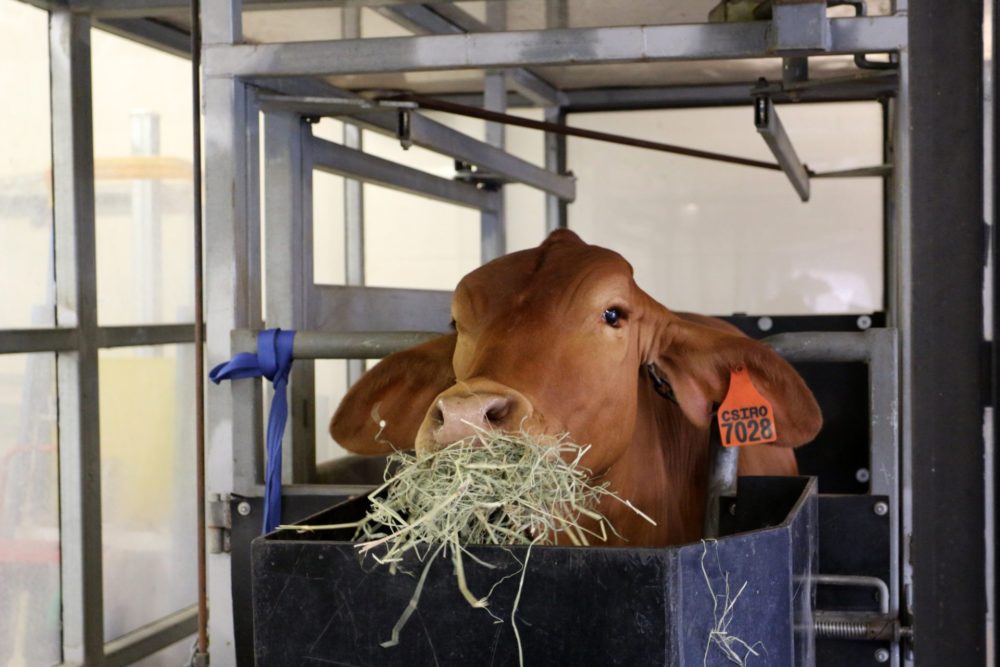



Article by: Hari Yellina
A long line of brown Jersey cows lined up for feeding time on a recent winter afternoon, fighting for a place. Blueberry snorted as he approached the end of the railing. Her lunch at the University of New Hampshire’s organic dairy farm today consisted of a regular hay and grain blend. But shortly, she and her fellow dairy cows would be introduced to a new ingredient: seaweed. This herd is part of a research project investigating the capacity of several varieties of seaweeds to reduce methane, a potent greenhouse gas that cows emit in a constant stream of burps. Andre Brito, associate professor of dairy cow nutrition and management at UNH, said, “Cattle is the second largest generator of methane in the United States.”
Methane levels in the atmosphere are now greater than they have been in the preceding 800,000 years, according to a recent assessment from the Intergovernmental Panel on Climate Change (IPCC). Methane is a major contributor to global warming. Despite the fact that it degrades faster than carbon dioxide, it is 25 times more effective at trapping heat. The culprits are bovine burps, which account for 95 percent of the methane emitted by cows as a byproduct of their digestive tract. Cow and other animal gas is the second-largest source of methane emissions in the United States, after the oil and gas industry.
Brito is part of a group of New England experts investigating if feeding seaweed to the country’s 90 million cattle could reduce methane emissions. This is how it goes. Cows are “ruminants,” mammals capable of digesting substances that humans cannot, such as grass. Ruminants actually ruminate, regurgitating their meal and digesting it further, but people “ruminate” by “chewing on” complex or unpleasant thoughts. That process comes with a cost. “Billions and billions of bacteria effectively digest the fibre for the animal,” Brito said of a cow’s four-chambered stomach. As a result, some of those micro-organisms release methane, which is belched out throughout the food’s journey from upstairs to downstairs.
Certain forms of seaweed include chemicals that prevent those microorganisms from producing methane. So, if you feed some seaweed to the cows, they will spew less methane. However, there is a snag. To date, the seaweed Asparagopsis taxiformis is the most effective at reducing methane emissions. It would be invasive to try to cultivate it off the coast of the United States. Growing it on land would have a significant carbon footprint. Brito is collaborating with Nichole Price, a senior research scientist at the Bigelow Laboratory for Ocean Sciences in East Boothbay, Maine, to locate an alternative seaweed. “The challenge is if there are seaweed species native to different places throughout the world, and specifically for us in the Northeast… that can be produced at the volume required to feed the thousands of cattle that we generate,” she added.
Price and her colleagues discovered a dozen local seaweed kinds, as well as dozens of single-celled microalgae, that may have comparable methane-inhibiting capabilities. They’re now putting them to the test in a facility full of dummy cow stomachs, dubbed the “bottle herd” by Price. In an incubator, the bottle herd is a collection of glass vials. Each is filled with a brownish-yellow liquid derived from the stomach of a cow.
Brito, on the other hand, believes that his herd of Jersey cows at the University of New Hampshire could be part of the solution. Brito is putting a seaweed possibility identified in the bottle herd at Bigelow Labs to the test: “Irish Moss,” a red seaweed from the Gulf of Maine. Small amounts are mixed along with the cows’ normal meal. Early data reveal a 15% to 20% reduction in methane emissions, he said. The findings are preliminary, and the researchers plan to test more varieties of seaweed in the future. Brito, on the other hand, is upbeat. “I think they should be performing a very excellent step towards a more sustainable animal agriculture or dairy cattle agriculture if they have a constant reduction of methane between 20 and 30 percent,” he added.